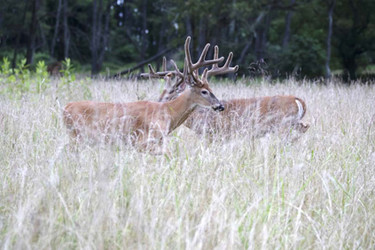Big Woods Whitetail — Interview with Beau Martonik
Posted by Kinsey's Outdoors on 22nd Oct 2020
Gear Up for the Big Woods
Big woods whitetail hunting is about as challenging as it gets. Not only do hunters have to deal with long treks across mountainous terrain, but the lack of agricultural food sources and typically lower deer densities test even the best woodsmanship. There’s no one piece of gear available that equates to automatic success in any hunting situation, but the combination of the right mentality and quality equipment can increase success ratios by leaps and bounds. Hunting in the big woods takes a lot of persistence, the ability to adapt, and great patience to be successful and one knows this better than Beau Martonik.
Martonik, a native of Pennsylvania’s vast Alleghany National Forest region, grew up hunting whitetails in one of the United States’ most storied big woods settings. Beau has spent his entire life perfecting both his strategy and gear list so as to be able to locate, pursue and kill mature bucks in some of the most challenging conditions in the country. Consistently punching tags in this terrain takes a purposeful and detailed approach and so I asked Beau to break down the process and system that leads to venison in the freezer and antlers on the wall, year after year.
Narrow The Search
Big woods bucks are crafty and unpredictable. Being travelers of long-distance makes these bucks especially hard to pattern. Instead of seeking out single-season patterns, Martonik stresses the value in looking for year-to-year patterns. “Bucks tend to do the same things season after season”, Beau elaborated, “So using trail camera data from prior years is a great way to make logical assumptions about what they will do in following seasons.” Quality trail cameras, with extended battery life, strategically placed along key terrain features, or social areas such as primary scrapes, are a great educational tool for the big woods hunter. Even in big woods settings, Martonik is still looking for an edge. He stresses that bucks in the big timber interact with edges much the same as they do in agricultural settings, but those edges look a bit different. Creeks, clear cuts, thickets, and benches are all examples of the types of edge that these bucks like to use for travel. Rut funnels such as ridge tops saddles also make for great cruising corridors in the mountains.
To locate these features, a quality mapping application is useful. Martonik employs the use of OnX to pinpoint locations he will later check during his scouting efforts. Remote and overlooked areas become quickly recognizable with the use of aerial and topographical maps; as do terrain funnels and vegetation changes that create the edges that big bucks love to use.
Gear Up
The challenge of hunting big woods whitetails will test your resolve, but it will also quickly show you any chinks in your gear “armor”. In this environment, quality equipment not only makes the hunt more enjoyable, but it can, indeed, improve success ratios. Once a hunter narrows the expanse of timber to several high percentage locations, having the right gear for the job is the next step in the process. “When it comes to this type of hunting, a beneficial piece of gear to have is a high-quality frame pack- if you are successful it will carry your kill out,” Beau said. “A ‘rut pack’ is also a huge benefit in the big woods; something that can integrate with a stand and sticks to get all the gear you need to the tree for an all-day sit.”
Martonik is also a huge proponent of high-level performance apparel systems. Mountain hunters have long been pushing the envelope in the testing and development of new and better layering systems and the concept has begun to show its value in the whitetail woods as well. He uses moisture-wicking base layers such as fast drying synthetics or natural merino wool fibers which retain their insulation capabilities even when they become damp from perspiration. The key, though, is to reduce the amount of sweat, period. To do this, Beau wears only a lightweight synthetic or merino layer when walking several miles to remote stand locations. And that quality pack referenced above? That holds the heavy outer layers that will be applied immediately after he cools down in his stand. Going deep into the timber and pursuing big woods ghosts requires pack-ability and thermal regulation. As such it is hard to overstate the importance of both a pack system and the apparel you choose.
Safety
Even with the advances in cell phone technology, if you are pushing the envelope and going where others aren’t willing to go, you will find yourself outside of cell phone service from time to time. This is an area where Beau takes no chances. “I am never not attached to the tree with a lineman belt or a safety line with a prusik loop attachment,” Beau said. Staying tied off 100% of the time is imperative when doing this kind of hunting. In fact, having two safety ropes often makes it easier to ensure you are tied in at all times, even when you are transitioning into and out of the treestand. Hunters should be aware of suspension trauma, a very serious and potentially lethal phenomenon that occurs when hanging for an extended time from a harness. Pooling blood in the suspended hunter’s legs can cause unconsciousness and unless rescued, eventually lead to death. For this reason, and others, Beau has started to carry a GPS phone which allows texts to send via satellite even from the most remote locations. Texts can include GPS coordinates for rescuers to use to find a hunter more quickly. These devices are worthwhile investments, and hunters with western aspirations should especially consider them to be a necessary purchase.
Success
The hunt in the mountainous timber of the Appalachian Mountains is, in itself, a challenge. However, having success in this environment is when the real work begins. Dragging a deer over two miles of rugged terrain is a grueling task and quite a time commitment. That’s why Martonik chooses to combine more western philosophy into his whitetail hunting and pack out his kills. Using the gutless method, Beau is able to get all the venison, cape, and his gear out of the woods in two trips. The aforementioned frame pack shines in this application. He carries a “kill kit” consisting of the tools he needs (game bags, knife, garbage bag, flagging tape, paracord) to skin and process the deer on the ground. With the gutless method, the abdomen of the deer is left intact and all the meat from the quarters and loin is removed and packed out with the frame. Beau’s go-to for skinning and processing in the field is his Havalon replaceable blade knife, and with this process, he is able to make quick work of a deer after the kill and get out of the woods faster and with less physical exertion than the traditional “deer drag”.
There is always more than one way to skin the cat, as they say. Martonik’s approach has evolved over his years in the timber through trial and error; and no doubt that kind of person who has the thirst for new adventure is the same kind of person who continually seeks new and better ways of doing things. But, when it comes to locating and killing big woods deer, the whole Martonik family is proficient, to say the least, and Beau has a systematic approach and his gear list pretty dialed in. So, I asked Beau what he believes is one of the biggest mistakes made by industry personnel when advising and instructing people on their gear choices for this “big woods” type of hunting. He replied, “From my experience working in retail, and now as someone who helps advise people on gear choices, I think the biggest thing people overlook is making certain that you understand the consumer’s intended use of the product. I am going to advise someone entirely differently if they are planning to walk several miles in hill country versus walking a couple hundred yards to hunt a field edge. It’s important to know their goals, and sometimes you have to be able to understand that maybe even better than they do themselves, so that you can make the proper recommendations for each individual hunter’s situation.”
To find more information on Beau Martonik, follow him on Instagram at @beau.martonik . He also produces a popular podcast series called East Meets West Hunt Podcast and runs the Instagram page @EastMeetsWestHunt. His website is www.EastMeetsWestHunt.com

